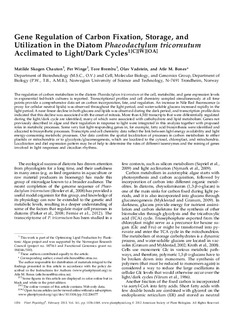| dc.contributor.author | Chauton, Matilde Skogen | |
| dc.contributor.author | Winge, Per | |
| dc.contributor.author | Brembu, Tore | |
| dc.contributor.author | Vadstein, Olav | |
| dc.contributor.author | Bones, Atle M. | |
| dc.date.accessioned | 2017-11-07T13:34:35Z | |
| dc.date.available | 2017-11-07T13:34:35Z | |
| dc.date.created | 2013-02-21T13:49:46Z | |
| dc.date.issued | 2013 | |
| dc.identifier.citation | Plant Physiology. 2013, 161 (2), 1034-1048. | nb_NO |
| dc.identifier.issn | 0032-0889 | |
| dc.identifier.uri | http://hdl.handle.net/11250/2464690 | |
| dc.description.abstract | The regulation of carbon metabolism in the diatom Phaeodactylum tricornutum at the cell, metabolite, and gene expression levels in exponential fed-batch cultures is reported. Transcriptional profiles and cell chemistry sampled simultaneously at all time points provide a comprehensive data set on carbon incorporation, fate, and regulation. An increase in Nile Red fluorescence (a proxy for cellular neutral lipids) was observed throughout the light period, and water-soluble glucans increased rapidly in the light period. A near-linear decline in both glucans and lipids was observed during the dark period, and transcription profile data indicated that this decline was associated with the onset of mitosis. More than 4,500 transcripts that were differentially regulated during the light/dark cycle are identified, many of which were associated with carbohydrate and lipid metabolism. Genes not previously described in algae and their regulation in response to light were integrated in this analysis together with proposed roles in metabolic processes. Some very fast light-responding genes in, for example, fatty acid biosynthesis were identified and allocated to biosynthetic processes. Transcripts and cell chemistry data reflect the link between light energy availability and light energy-consuming metabolic processes. Our data confirm the spatial localization of processes in carbon metabolism to either plastids or mitochondria or to glycolysis/gluconeogenesis, which are localized to the cytosol, chloroplast, and mitochondria. Localization and diel expression pattern may be of help to determine the roles of different isoenzymes and the mining of genes involved in light responses and circadian rhythms. | nb_NO |
| dc.language.iso | eng | nb_NO |
| dc.publisher | American Society of Plant Biologists | nb_NO |
| dc.relation.uri | http://www.plantphysiol.org/content/early/2012/12/03/pp.112.206177.full.pdf+html | |
| dc.title | Gene regulation of carbon fixation, storage, and utilization in the diatom phaeodactylum tricornutum acclimated to light/dark cycles | nb_NO |
| dc.type | Journal article | nb_NO |
| dc.type | Peer reviewed | nb_NO |
| dc.description.version | publishedVersion | nb_NO |
| dc.source.pagenumber | 1034-1048 | nb_NO |
| dc.source.volume | 161 | nb_NO |
| dc.source.journal | Plant Physiology | nb_NO |
| dc.source.issue | 2 | nb_NO |
| dc.identifier.doi | 10.1104/pp.112.206177 | |
| dc.identifier.cristin | 1013178 | |
| dc.relation.project | Norges forskningsråd: 207794 | nb_NO |
| dc.description.localcode | Copyright American Society of Plant Biologists 2012. All rights reserved. Open access. | nb_NO |
| cristin.unitcode | 194,66,15,0 | |
| cristin.unitcode | 194,66,10,0 | |
| cristin.unitname | Institutt for bioteknologi og matvitenskap | |
| cristin.unitname | Institutt for biologi | |
| cristin.ispublished | true | |
| cristin.fulltext | original | |
| cristin.qualitycode | 2 | |
